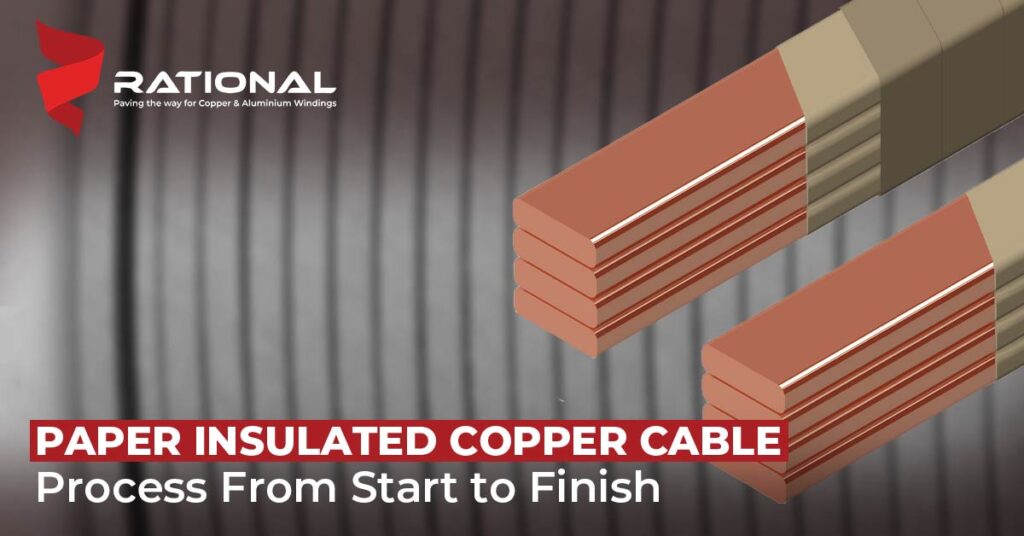In the world of electrical and power transmission, paper-insulated copper cables (PICC) stand as a hidden champion. They’re essential in everything from high-voltage substations to your daily commute’s railway system. But what exactly goes into manufacturing these cables?
Let’s take a closer look at the manufacturing process of paper-insulated copper cables, from start to finish, with some insights from Rational Engineers, the renowned paper-insulated copper cables manufacturers.
1. The Raw Material: Copper Wire
It all begins with the copper wire. Copper is chosen for its excellent conductivity, which ensures that electricity can flow efficiently with minimal loss. At Rational Engineers, copper wire is sourced from high-quality suppliers, ensuring that every piece is pure and ready for transformation into the most effective electrical conductor.
2. Preparation: Drawing and Cleaning
Once the copper is sourced, the next step is to draw it into thin wires, often through a process called wire drawing. This involves pulling the copper through a series of dies to achieve the desired diameter. During this stage, the copper undergoes thorough cleaning to remove any impurities or oxide layers that could impact its performance. This ensures that only the finest copper makes it into the final product.
3. Insulation: The Paper Layer
Now, the copper wire is ready to be insulated. This is where the magic of Paper-Insulated Copper Cables truly begins. At Rational Engineers, the insulation process involves wrapping the copper wire with multiple layers of high-quality paper. The paper is impregnated with a special insulating compound, usually a type of oil or wax, which provides both dielectric properties and moisture resistance. The goal here is to ensure that the copper wire remains protected from environmental factors and electrical interference.
But why paper, you ask? Paper has excellent dielectric properties, is environmentally friendly, and, with the right treatments, provides the perfect balance of insulation and flexibility. Additionally, paper insulation offers a longer life span and greater resistance to heat, making it ideal for power transmission applications.
4. Twisting: Enhancing Durability
Next, the paper-insulated copper cables are twisted together to form bundles or cores. This process helps to enhance the strength and flexibility of the paper-insulated copper cables, ensuring they can withstand physical stresses during installation and operation. These twists also help to maintain a consistent electrical flow and minimize the risk of short circuits.
5. Outer Insulation: For Extra Protection
While the paper insulation does the heavy lifting in terms of protecting the copper, additional outer insulation is applied to safeguard against environmental damage. This could involve layers of PVC, rubber, or other durable materials depending on the intended application of the cable. The outer insulation protects against mechanical damage, UV exposure, and moisture, making sure the paper-insulated copper cables can withstand the test of time.
6. Testing: Quality Assurance
Before a batch of Paper-Insulated Copper Cables can be shipped out, it undergoes rigorous testing. These paper-insulated copper cables must meet industry standards for things like dielectric strength, insulation resistance, and mechanical properties. At Rational Engineers, every cable is subjected to tests that simulate real-world conditions, ensuring that they meet or exceed safety and performance criteria.
Testing is an essential part of the process because, in power transmission, reliability is paramount. No one wants to face power interruptions or electrical hazards due to faulty cables, so a strict quality control process ensures the end product is flawless.
7. Final Product: The Paper-Insulated Copper Cables are Ready for Use
Once the paper-insulated copper cables pass all tests, they are rolled up and packed, ready to be sent out to clients. Whether used in power plants, transmission lines, or railways, the final product is one that guarantees optimal performance, safety, and longevity.
Rational Engineers, with their advanced manufacturing techniques, ensure that paper-insulated copper cables are manufactured with precision and care, offering a product that stands the test of time and provides the reliability clients need.
Conclusion
The manufacturing of Paper-Insulated Copper Cables is a process that combines the art of engineering with the science of materials. From the careful selection of copper to the meticulous layering of paper insulation and the final testing phase, every step is crucial to ensure a durable, high-performance product.
We can rely on companies like Rational Engineers, who specialize in the manufacturing of paper-insulated copper cables, industries worldwide, for their power transmission needs. The process, while detailed and intricate, results in a product that powers everything from industrial plants to the train systems that keep our cities moving.
So next time you flick on a light switch or ride the subway, remember: the power behind it all could very well be carried by Paper-Insulated Copper Cables, and it’s due to the precise and skillful manufacturing process that makes it all possible.

